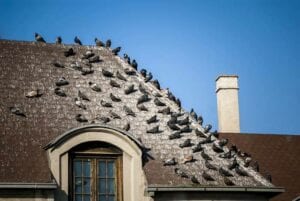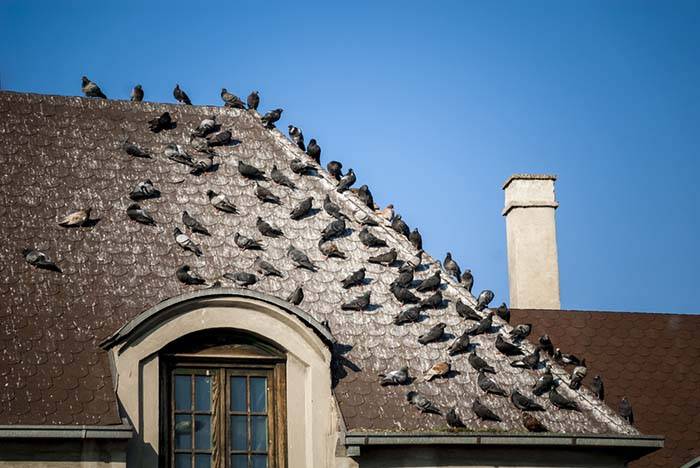Pigeons are easily recognizable by their distinct coloring. With their white-gray rump, iridescent facial feathers and black stripes on their tails and wings, these birds are easy to identify. Pigeons reproduce incredibly quickly, and mating occurs year round. Despite their speedy reproduction rates, pigeons are monogamous creatures that lay one or two eggs at a time, which hatch within 18 days. Baby pigeons are fed “pigeon milk,” or regurgitated food, by both their parents until they are old enough to find food on their own.

Pigeon Habits
Pigeons prefer grains, but they are not picky when it comes to their meals. Much of their diet comes from humans who drop or spill their food, or place leftovers in open trash cans that pigeons can scavenge. These birds like to hang out on ledges and other narrow areas high above the ground. They like to roost in covered, high areas, and their nests can frequently be found in places like steeples or under bridges.
Pigeon Habitats
Pigeons are true city dwellers who are dependent on humans to provide food, roosting and nesting sites. This is why you often see them gathered around city parks, buildings and bridges. Pigeons are also commonly found around agricultural areas, as well as warehouses, feed mills and grain elevators.
Pigeon Threats
Often called the “rats of the sky,” pigeons can be incredibly problematic. These birds can carry dangerous diseases like cryptococcosis, toxoplasmosis, salmonella, food poisoning and more. Their droppings may also harbor the growth of fungus, which causes histoplasmosis, which can accelerate the aging of structures and statues. Even more alarming, these social birds often serve as unwitting hosts to fleas, lice, mites, ticks and other pests, which can create secondary infestations.
Signs You Have a Pigeon Infestation
The most obvious sign of a pigeon infestation is the presence of many birds, pigeon nests or their droppings.
How To Prevent an Infestation
The best way to prevent pigeons from roosting in or near your house is to make your home undesirable. Remove any and all food they could get access to, place pointy objects on pigeon-friendly surfaces and place nets across open areas.
How to Get Rid of Pigeons
The steps for pigeon removal and prevention are the same: make their living space uninhabitable. Killing pigeons is not effective and it will not root out the source of the problem. Instead, eliminate all food sources and remove their nests and replace them with objects that prevent them from returning.
Pigeon Patrol Products & Services is the leading manufacturer and distributor of bird deterrent (control) products in Canada. Pigeon Patrol products have solved pest bird problems in industrial, commercial, and residential settings since 2000, by using safe and humane bird deterrents with only bird and animal friendly solutions. At Pigeon Patrol, we manufacture and offer a variety of bird deterrents, ranging from Ultra-flex Bird Spikes with UV protection, Bird Netting, 4-S Bird Gel and the best Ultrasonic and audible sound devices on the market today.
Voted Best Canadian wholesaler for Bird Deterrent products ten years in a row.
Contact us at 1- 877– 4– NO-BIRD, (604) 585-9279 or visit our website at www.pigeonpatrol.ca
Pigeon/Pigeon Patrol / Pigeons Roosting / Vancouver Pigeon Control /Bird Spikes / Bird Control / Bird Deterrent / Pigeon Deterrent? Surrey Pigeon Control / Pest /Seagull deterrent / Vancouver Pigeon Blog / Birds Inside Home / Pigeons in the cities / Ice Pigeons/ What to do about pigeons/ sparrows , Damage by Sparrows, How To Keep Raccoons Away, Why Are Raccoons Considered Pests/ De-fence / Pigeon Nesting/ Bird Droppings / Pigeon Dropping/ woodpecker control/ Professional Bird Control Company/ Keep The Birds Away/ Birds/rats/ seagull/pigeon/woodpecker/ dove/sparrow/pidgeon control/pidgeon problem/ pidgeon control/flying rats/ pigeon Problems/ bird netting/bird gel/bird spray/bird nails/ bird guard

